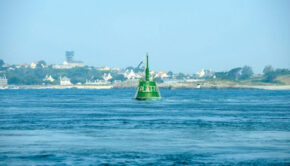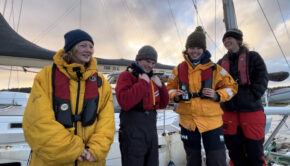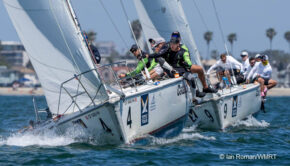My first regatta in 2013 was run perfectly – Part 2
Published on July 9th, 2013
In his second and final report of this series (click here for Part 1), Glenn McCarthy shares a scenario in the sport that is affecting the enthusiasm of the recreational racer…
I had not realized until this weekend that Tom Neill (he had a number of boats called Nitemare, the last boats he owned were a Melges 24 and a Santa Cruz 70) was a Prophet.
We were at the starting line one time, he on his sled, we on ours, but Tom’s cancer had reached the stage where he was sitting on a lawn chair on the afterdeck, with an oxygen bottle, with a tube in his nose. Everyone respected that he had less than a year to live and admired his strength to keep racing and having fun for as long as he could. He was, and is, an inspiring model for anyone to follow to enjoy life for as long as possible.
It was a beautiful summer day, the sleds sailing back and forth doing 4.5 miles per hour of boat speed on mainsail alone. The Postponement flag hung and hung and hung. We were itching to race, that’s what we came for. What would the race provide?
It would have been on the slow side going upwind, and would have been a long really slow ride downwind, not downwind really, it would have been pole on the head stay and lots of jibes, zig-zagging to keep some boat speed going, and jibing a lot. No doubt we would be close to a time limit race, but we would have made it across the finish line in those conditions.
We shared the starting line with other classes, the Farr 40’s, Beneteau 40.7’s, etc. More than likely, they wouldn’t make it around the course in the time limit. But the sleds could and there were no overall prizes to contend with, only section prizes.
So, Tom shouts, “Hey, Race Committee, start the race. I’m dying to race out here!” (You really had to know Tom, and you caught his wit right now.) We didn’t race, we kept sailing back and forth at 4.5 miles per hour. The postponement flag held the day.
As our other boat, the small boat, had become a little tired beginning 10 years ago, this winter the decision was made to make her like new. It had an odd original gel coat job from the factory. From the day we purchased this boat about 20 years ago, the gel coat was chalking. We buffed it, lightly sanded it, polished it, waxed it, Tefloned it, and kept trying different chemicals and still it powdered. And I don’t mean a little. When we would wash the boat on the trailer in the parking lot, we left a white shape on the ground of our boat on the blacktop. This was amusing and embarrassing all at the same time. The gel coat had ablated away to the point where you could easily see the fiberglass in many areas. So the skipper sanded off all of the remaining gel coat over the winter, prepped it and a painter put on a new coat of Imron paint.
Five years ago, a little snaggle caused the mast to be bent. It was straightened by bending it around a tree and we have been using it since (a new mast came in 5 years ago and we left it wrapped up in plastic as our “back up” mast). When you re-bend a mast, you can see that it’s not straight and still has some waviness as you look at it from bottom to top. Additionally, the leech of the jib touched the spreader on one tack and was 7” away from the spreader on the other tack. The mast was torqued a bit. It was not quite straight, but usable. So making the boat like new this year, we brought the new mast out of the plastic, fitted her, tuned her and made the boat race ready.
It had been 217 days since the last fall regatta and this was the first spring regatta of the year – 3/5 of a year had passed with a long cold winter and an equally long cold spring. The weather had just turned for the better in the past week. We were champing at the bit to get out of the gates and see what this boat could do.
With this being a two day event, we geared up for Saturday, launched early to test things out and spent an hour under deck making the range of adjustments on control lines just right. There was a good breeze as we tested everything out. We were ready to go.
Welcome to Midwest sailing. The wind does four things like clockwork. It shifts a whole lot, the speed of the wind goes up and down like a window shade, it is patchy, and commonly it fills in from one side before it gets to the other side of the race course. Seasoned veterans have raced in these conditions their whole life. Is it a crap shoot racing in these types of conditions? You bet! Is some luck involved? You bet! Does the guy who is still new and young at sailing who shows up with an old boat and old sails have a chance at winning a race? You bet!
A 50-footer sails along the coast delivering the boat under main only and a Laser is sailing off the beach and sees it coming. There’s no starting line or finish line, there’s no notice of race or sailing instructions, no start time or any of that, but each time there are two sailboats on the water, a race breaks out! The Laser sailor suddenly hikes harder, makes tuning adjustments, the 50-footer tweaks their trim, the couple of people on the deck move out to the rail and the race is on! It lasts less than 5 minutes, the 50-footer quickly goes out of range and everyone relaxes again. Point being, everything and anything is a race.
In the past, before the perfection push by ISAF and US Sailing, we would race in fluky conditions. We would find a winner, and all places in between down to the last place boat would be determined. And do you know what? No one quit (except Ken Himmelright who simply had no patience for light air sailing) in protest that it didn’t meet the definition of ISAF or US SAILING that it wasn’t a “race.” We all considered it a race and worked harder in those conditions than when we do when it is blowing 20.
We do have a few racers today who have drunk the IOC/US Sailing/ISAF Jimmy Jones Kool-Aid. But they don’t have any Olympic ambitions. They read the Race Management Manual and expect races not to be run in crapshoot conditions. There are plenty of sailors who would rather race in crapshoot conditions than not race at all. If these Kool-Aid Drinkers insist on these perfect conditions for racing, then why don’t they get on the IOC/ISAF/US Sailing track? Those few “rock stars” who think the Race Committee did the right thing for two days, not running any races, is this what is going to grow sailboat racing? By not racing?
Competitors came from a four state region, paid a $135 Entry Fee, many stayed at hotels for a two nights, spent anywhere from $3.60 to $4.35 for a gallon of gas for their drives there. A lot of expense and a lot of time gets invested and we want to race. We don’t care that it doesn’t it the IOC model of perfect racing. Just start the races, and let the racers figure out how to get to the finish line the fastest.
Years ago we went to the Bacardi Cup in Miami, six races over six days. Driving down to Florida and back filled up a week’s vacation. The PRO had decided that the winds had to be between 12 and 18 and steady in forecasted direction for the duration of the race. His favorite flag was the Cat in the Hat (postponement). He used it ashore a lot and out on the committee boat. At the start of the week he was much more likely to use it, but when pushed with his back against the wall and running out of days to get races in, he would stop using it, set up double headers, and sail in conditions that were much less desirable than the days he passed on earlier in the week.
After doing this for 5 years, and in the fifth year he ended up on the last two days of the event running double-headers for a total of 4 races for the week, I was done. I did not need to take a week’s vacation to race 4 races over 2 days that I could have done on a weekend regatta not missing any work. The strive for race course perfection designed and trained by ISAF and US Sailing is a complete turn off.
So what exactly is a champion? Is a champion one who only performs well within the box of 6 to 22 miles of wind and shifts less than 8 degrees? This is true for the Olympics. But for the weekend warriors, people just looking for some fun, relaxation, recreation, new stories to tell at the bar, why shouldn’t we crown a champion that can deal with a much wider range of conditions?
Why shouldn’t we have races that are crapshoots? Why shouldn’t we race when there are 60, 180 or even 360 degree windshifts? Why shouldn’t we race when there is barely a breath of wind, keep the course real short and let us go? Why shouldn’t we race when the dogs are being blown off chains (and for those who aren’t skilled at this level, please stay ashore, jump in a rescue boat, or join a team with experience in these conditions so you can learn before going out and trying).
Damn you IOC, Damn you ISAF, and Damn you US Sailing. Sailors drive for hours to come to an event. There are short times where wind is in where races could be run. Those races would have been those types where on each leg all boats gain or lose 12 boats at each rounding. At the end of the day the cocktail hour would have been full of stories about this boat and that boat – just like it would if we had sailed a perfect Olympic race. But we would not have sailed it in perfect Olympic conditions, we would have sailed it in recreational fun, crazy, hair pulling conditions, which is what we weekend warriors are about. Race Management perfection is now being measured in not running races.
It is time to take some pages out of the Race Management Manual and burn them for recreational sailboat racing. We need to go back to the days where the Race Management’s job was to start and finish races and keep score – that’s all. We need to completely eliminate the responsibility placed on Race Management to assure a “fair contest.” We need to eliminate the tool that allows Race Management to bring in Olympic fairness to our race courses.
In two weeks we will make an 11 hour round trip drive to another Midwest event, to try again where Race Management has been trained by the IOC/ISAF/US Sailing model. We will continue to be sure to keep our expectations low that we might get some races done. They, too, are a facility that prides itself on following the IOC/ISAF/US Sailing model of Race Management.
Tom Neill, the Prophet, was 100% right. We’re “dying to race out here.” In Tom’s terms it was that he had been given a time limit on life. The rest of us are happy go lucky, not knowing what our time limit of life is, or just take the more cliché version – we’re dying to race. God bless you, Tom. God bless you.
Source (Page 12): http://lmsrf.org/lmsrf/images/stories/newsletters/2013_06_LMSuRF.pdf








 We’ll keep your information safe.
We’ll keep your information safe.